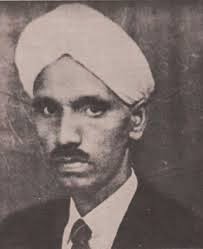By P V Gopalakrishnan
Tamil cinema was literally born in 1910, with the release of the first silent ‘Tamil’ film ‘Keechaka Vadham’, produced, directed, shot and edited by R. Nataraja Mudaliar, known today as the father of Tamil cinema. The film was based on an episode from the epic Mahabharata & was received very well.
It is said that Nataraja Mudaliar met one Stewart Smith, a cinematographer from Britain who was then filming a documentary on Lord Curzon & learnt the basics of cinematography from him. Later, in 1915, Mudaliar also established South India’s first film studio at Purasawalkam, Madras. In this first silent Tamil movie, stage artistes of that time, Raju Mudaliar and Jeevarathnam played the roles of Keechaka and Draupadi respectively. The cost of this 600 feet length film is said to be Rs. 35,000, then considered expensive. The production was completed in just five weeks, with Pammal Sambandha Mudaliar writing the screenplay.

Nataraja Mudaliar PC: unknown
Some sixteen long years later, ‘Kalidas’ was the first Tamil Talkie film (shot at Bombay) to be released in October 1931 on Diwali Day, as produced by Ardeshir Irani & directed by H.M.Reddy. P. G. Venkatesan and T. P. Rajalakshmi did the lead roles in the movie, which, though principally in Tamil, also contained additional dialogues in Telugu and Hindi.
When the film reels arrived by train at Madras Central Station from Bombay, thousands flocked there to follow the reel box, showering flowers all the way to Kinema Central, the theatre where it was screened (later known as Murugan Theatre).
However, according to Randor Guy, Kalidas was a “crude experiment” with poor lip sync. Despite the numerous technical flaws the film had, it received critical acclaim & became a major commercial success. I understand, no print of this landmark talkie film is available now.

PC: unknown
It is a relevant point to ponder here, as to how, when the films took avatar as above, did the film ‘industry’ then get their actors! Well, the actors for cinema were sourced from stage plays. The evolution narrated below would explain the anthology in that regard.
The stage plays had their antecedent in street plays literally called ‘theru koothu’, which, as a form of entertainment, has its origins to the Sangam periods of Tamil Nadu & forms part of its ancient Tamil culture. The subjects of Koothu have been from religion or history. Even today ‘therukoothu’ happens in rural areas particularly on special days or during temple festivals. With Its informal dance structure, therukoothu depicted scenes with little dialogues but with abundant songs, often sung by Artists in their own voice. They were dressed in complex heavy costumes and bright elaborate makeup. Males often played even female characters.
Over the time, stage plays got evolved. In Tamil Nadu there were formidable stage play troupes some of which created artistes who became to be absorbed as cine actors, when cinema appeared. As such the early cine actors had the characteristic that profiled characteristic stage actors with stopping dialogue delivery, often loud. There seems to have been seamless supply of actors to cinema, this way, as there was no other institutionalized training places like Film Institutes!
In the bygone era, many renowned Drama Companies such as Madurai Bala Meena Rasika Ranjani Sabha, Sri Bala Shanmukananda Sabha, Kannaiyar Company, Madirai Sridevi Bala Vinodha Sabha, Tiruchi Rasika Ranjani Sabha kept the flag flying high in the field of Tamil Dramatics and produced great Artistes like S.G.Kittappa, K.B.Sundarambal, T.K.S.Brothers, N.S.Krishnan, KaLi.N.Rathnam, K.P.Kesavan, K.K.Perumal, K.P.Kamatchi, P.U.Chinnappa, M.G.Ramachandran, S.V.Sahasranamam, M.V.Mani, Thyagaraja Bhagavathar & many more.
There were personalities like Sankaradas Swamigal & Pammal Sambanda Mudaliar who brought dignity to stage plays, in which people from respectable backgrounds did not part take in the prior period. They gave grammar to the stage and in their own way institutionalized play stages with astute discipline.

Sankardas Swamigal PC: unknown
Sankaradas Swamigal, who is largely considered as the father of Tamil Theatre, started in 1910 his own drama company known as ‘Samarasa Sanmarga Nataka Sabha’. It was here that the legendary actor S.G.Kittappa learnt his ropes. Around this time, the concept of “Boys Company” – some sort of Gurukula System was slowly gaining popularity. In this system, boys stayed together residentially and learnt under masters of drama.
Sankaradas Swamigal was involved with Bala Meena Ranjani Sangeetha Sabha which had on its rolls several boys who would go on to become subsequently big names in the world of theatre and cinema, such as Nawab T.S.Rajamanickam, M.R.Radha, S.V.Venkatraman and K.Sarangapani. Swamigal thus had the privilege & distinction of having mentored several stalwarts.
In 1918, Swamigal with likeminded few started his own Boys Company, ‘Tattva Meenalochani Vidwat Bala Sabha’. It was here that the celebrated T.K.S. Brothers were brought under the tutelage of Swamigal. T.K.Shanmugam, who was later known as “Avvai Shanmugam’ (Lloyds Road was renamed after him as Avvai Shanmugam Road) was the favorite of Swamigal.
Swamigal maintained very strict discipline and kept vigil over his wards against any vices and any violators were reprimanded.
In short, Sankaradas Swamigal was a one man institution in those days, which, should we say, was unknowingly emulated by later institutionalized training formats such as Film Institute or other acting schools?
(to be continued)
